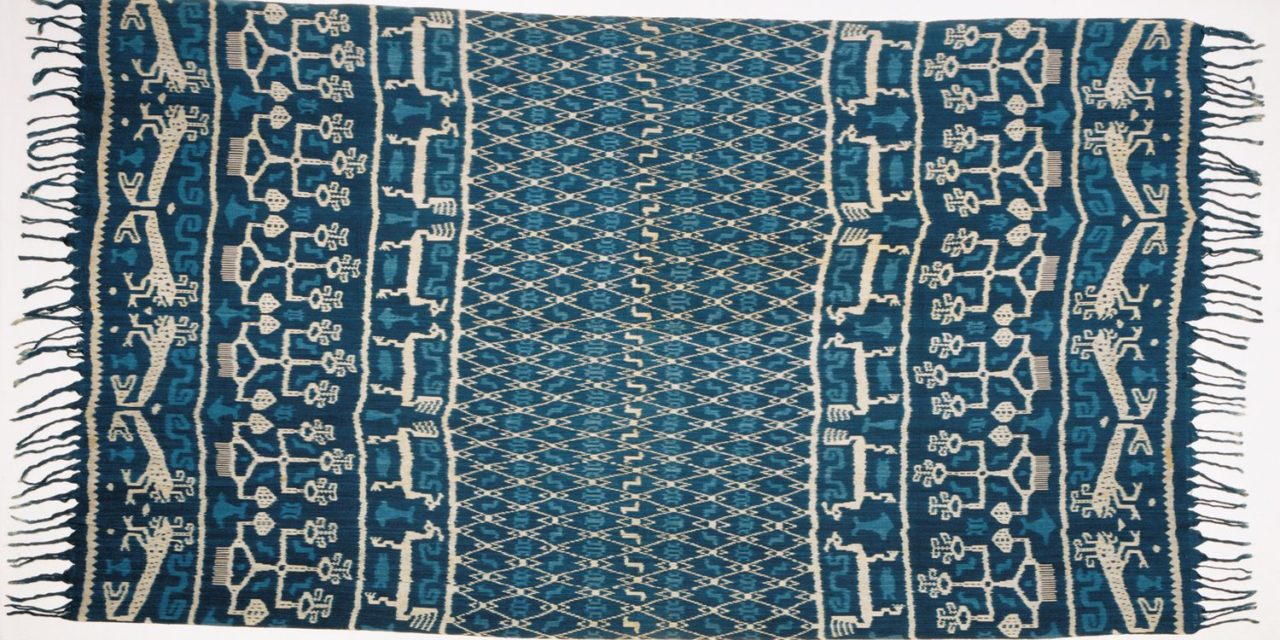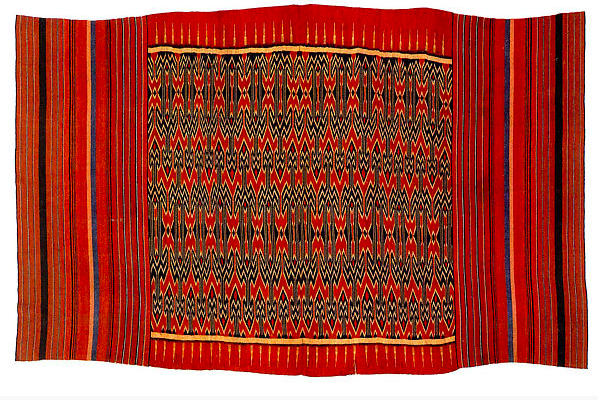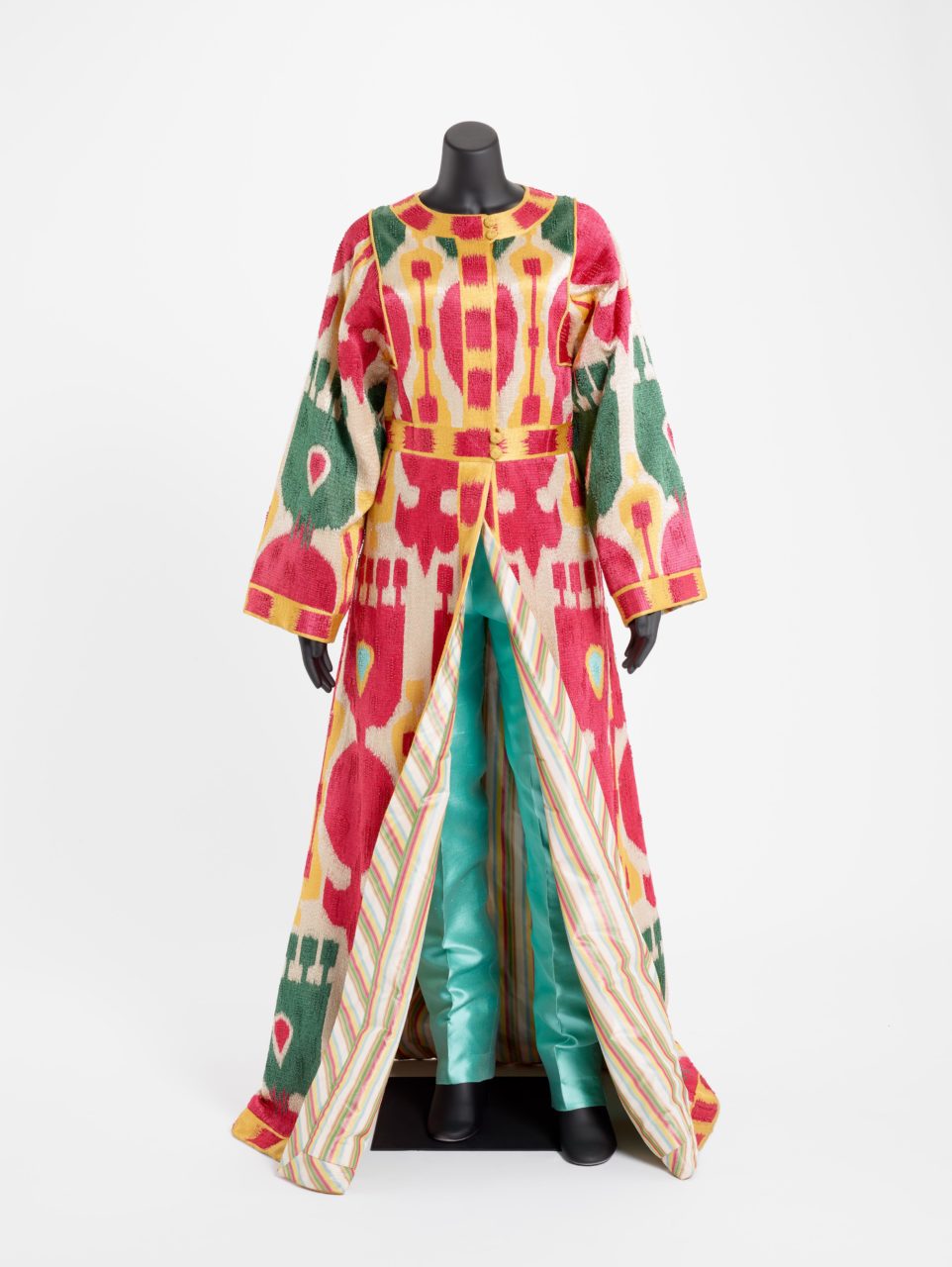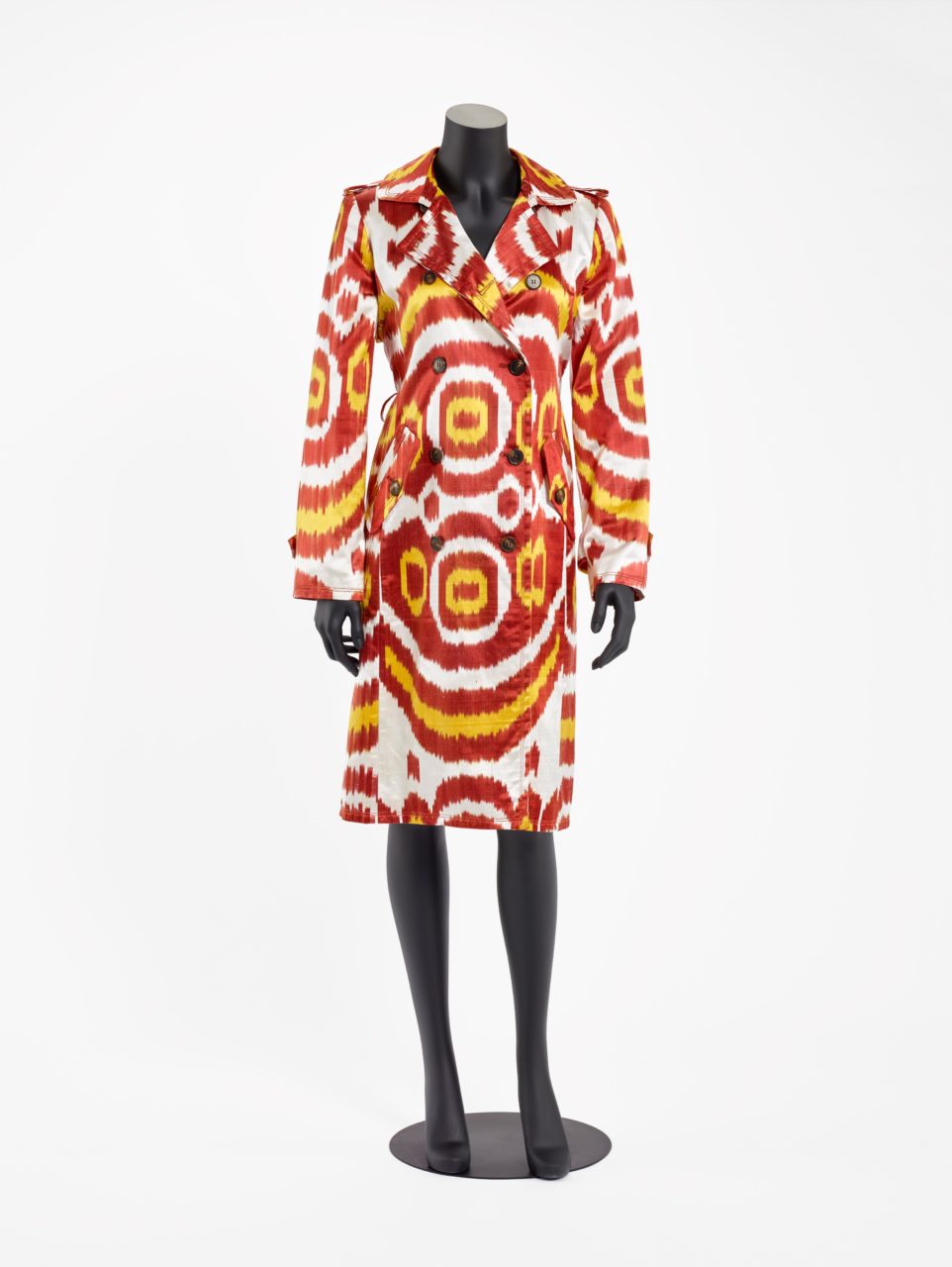Ikat is a textile patterning technique in which the warp or weft yarns are dyed prior to weaving the fabric.
The Details
In the Berg Encyclopedia of World Dress and Fashion (2010), Abby Lillethun describes the basic ikat process and its specific application in Central Asia:
“Vibrant, colorful fabrics called ikats, executed with masterful craftsmanship, were the zenith of a textile renaissance in nineteenth-century Central Asian urban centers. Ikat, an Indonesian word, refers to a textile-patterning technique involving binding yarns to resist dye before weaving and the textiles made using this tied-yarn dye-resist technique. The technique is found in several locations in the world and may involve binding both warp (lengthwise) and weft (crosswise) yarns, but, in Central Asia, only warp yarns are bound.”
An Indian textile fragment (Fig. 1) shows the ikat technique in practice with the design of alternating stripes of red and white, and yellow, green, and with the dark brown brocade weaving on the red cotton weft.
Fig. 1 - Artist unknown (Indian). Ikat, Early 20th century. Silk; 13.5 x 29 cm (5 5/16 x 11 7/16 in). Boston: Museum of Fine Arts, 25.488. Gift from Ananda K. Coomaraswamy, July 16, 1925. Source: Boston MFA
Beyond Central and South Asia, ikats became one of the most important, widespread, and technically sophisticated of all Indonesian textile traditions, where boldly patterned ikat fabrics are created by women and used by both sexes. Traditionally textiles in Indonesian society are both literally and figuratively interwoven with an individual’s life–from earliest infancy to the wrapping of the funerary shroud–as seen in this vibrant intricately woven ikat shroud (Fig. 2) from the Met’s “The Fabric of Life: Ikat Textiles of Indonesia” exhibition in 2006.
Fig. 2 - Artist unknown (Torajan). Shroud (Sekomandi), Late 19th century. Cotton; (67-1/2 in). New York: The Metropolitan Museum of Art, 1990.335.20. Gift of Anita E. Spertus and Robert J. Holmgren, in honor of Douglas Newton, 1990. Source: The Met
In the Encyclopedia of Clothing and Fashion (2005), Ruth Barnes describes the ikat process in great detail:
“prior to weaving, warp (lengthwise yarn) or weft (crosswise thread) or sometimes both are tied off with fiber knots that resist absorbing color and are then dyed. To facilitate the pattern tying, the threads are set up on a frame. They are then grouped into bunches of several threads to be tied at once; this results in the creation of knot units from which the overall pattern is built up. Resist ties are removed or new ones added for each color; their combinations create the design. After dyeing is completed, all resists are opened, and the patterned yarns are woven.”
Barnes goes on to describe the word’s origin and its many types, writing that:
“The word ‘ikat’ comes from the Malay-Indonesian word for ’tie’; it was introduced into European sources of textile technology and history in the early twentieth century when Dutch scholars began paying attention to the rich textile traditions of the Netherlands Indies, the present-day Indonesia. Depending on whether the tied fibers are applied to the warp or weft, the technique is identified as either warp ikat or weft ikat. A third variety, double ikat, combines both warp- and weft-tied resist.
For the pattern to be visible, the resist-dyed thread system has to be the prominent one, so for warp ikat, the weave has to be warp-faced, and weft ikat needs a weftfaced structure, which means that either warp or weft is predominantly visible. Plain weave is especially suitable for showing the ikat’s design, but for weft ikat, a twill weave may also be used. Double ikat, where the design is built up from both systems, should ideally by [sic] woven in a balanced weave, with warp and weft equally visible. All textile fibers may be used for ikat, although silk and cotton are the most common ones.”
Fig. 3 - Artist unknown (Indonesian Sumatran). Cover/Shroud, Early 20th century. Ikat-dyed cotton plain weave; 268 × 150 cm (8ft. 9 1/2 × 59 1/16 in). Philadelphia: Philadelphia Museum of Art, 1928-80-2. Gift of Nancy Andrews Reath, 1928. Source: PMA
Fig. 4 - Artist unknown (Indonesian (Sumatran)). Head wrapper (ikat kepala), Late 19th century. Silk, gold wrapped paper-covered thread, weft yarn resist-dyed (ikat), discontinuous supplementary weft patterning; 93 x 88 cm (36 5/8 x 34 5/8 in). Boston: Museum of Fine Arts, 30.824. Maria Antoinette Evans Fund. Source: Boston MFA
Another example of the interwovenness of ikat textiles or the “tie” to one’s life and the textiles made can be seen in this intricately woven ikat cover/shroud (Fig. 3), serving to enshroud the dead and perhaps showing indigenous aesthetics from the Island of Flores.
In the Encyclopedia of Modern Asia (2002), Linda B. Arthur describes the process of how the highly prized double ikat cloth is produced in Indonesia:
“the dye is applied to the warp yarns prior to weaving. The design is seen in the finished yarn goods, and is a result of the dyed warp yarns being woven with plain weft yarns, a process known as single ikat. When the warp and weft yarns are both resist dyed, an extremely complex form of double ikat results; these geringsing cloths are rare and are made only in Tenganan on Bali. These cloths are the most highly prized Indonesian textiles.”
The intricacy of said ikat technique can be seen in this square (Fig. 4), where violet-red ground silk cloth has an all-over abstract zigzag design created by the weft ikat technique in dark purple, yellow-orange, and natural white. There is a narrow crosswise border on each end with small repeating abstract geometric and floral motifs created with supplemental gold-wrapped thread and a similar border hand-stitched along each lengthwise edge.
Its Afterlife
C
ontemporary designer Oscar de la Renta has been credited by some for launching the trend of incorporating ikat designs in Euro-American fashion and the motifs soon later spread to upholstery, stationary, and wallpaper. According to Vanessa Larson, “The Dominican-born designer was so taken with the textiles that he visited Uzbekistan and commissioned local weavers to produce fabrics for the French label.” One of his most notable collections in doing so was in 1997 when he designed a spring/summer haute couture collection for Pierre Balmain’s fashion house; see, for example, a silk taffeta robe in a bold geometric pattern paired with teal green silk shantung pants (Fig. 5). In some of his later collections, you can see how he incorporated a vividly colored ikat pattern in a traditional silohuette, creating a bold classic trench coat in a 2005 spring collection (Fig. 6). In a more haute couture setting in 2013, the designer intricately wove an ikat design into a floral pattern down the back of silk and wool jacquard gown (Fig. 7). As seen in these pieces, the designer incorporated or referenced ikats in several collections he designed for both Balmain and his own fashion label up until his death in 2014.
Fig. 5 - Oscar de la Renta (Dominican, 1932-2014). Evening Ensemble, Spring/Summer 1997 Collection. Polychrome silk embroidery and silk taffeta; pants of silk shatung. Washington: Smithsonian Institution’s Arthur M. Sackler Gallery, ELS2018.6.1. Collection of Annette de la Renta. Source: Smithsonian Institution
Fig. 6 - Oscar de la Renta (Dominican, 1932-2014). Ikat classic trench coat, Spring 2005 collection. Silk and cotton. Washington: Smithsonian Institution’s Arthur M. Sackler Gallery, ELS2018.5.2. Oscar de la Renta Collection. Source: Smithsonian Institution
Fig. 7 - Oscar de la Renta (Dominican, 1932-2014). Ikat-patterned gown, Fall 2013 collection. Silk and wool jacquard. Washington: Smithsonian Institution’s Arthur M. Sackler Gallery, ELS2018.5.1. Oscar de la Renta Collection. Source: Smithsonian Institution
References:
- Arthur, Linda B. “Clothing, Traditional—Indonesia.” In Encyclopedia of Modern Asia, edited by Karen Christensen and David Levinson, 115-117. Vol. 2. New York, NY: Charles Scribner’s Sons, 2002. Gale eBooks (accessed March 2, 2021). http://www.worldcat.org/oclc/956663506
- Barnes, Ruth. “Ikat.” In Encyclopedia of Clothing and Fashion, edited by Valerie Steele, 231-233. Vol. 2. Detroit, MI: Charles Scribner’s Sons, 2005. Gale eBooks (accessed March 2, 2021). http://www.worldcat.org/oclc/870126526
- Freer Gallery of Art & Arthur M. Sackler Gallery. “Exhibition Highlights.” Accessed March 20, 2021. https://asia.si.edu/exhibition/highlights/.
- Freer Gallery of Art & Arthur M. Sackler Gallery. “To Dye For: Ikats from Central Asia.” Accessed March 20, 2021. https://asia.si.edu/exhibition/to-dye-for/.
- Larson, H. Vanessa. “The Enduring Influence of Ikat Fabric, from Oscar de La Renta to Contemporary Design.” Hyperallergic, May 11, 2018. https://hyperallergic.com/441928/to-dye-for-ikats-from-central-asia-arthur-m-sackler-gallery-oscar-de-la-renta/.
- Lillethun, Abby. “Textiles of Central Asia.” In Berg Encyclopedia of World Dress and Fashion: Central and Southwest Asia, edited by Gillian Vogelsang-Eastwood, 97–100. Oxford: Berg Publishers, 2010. Accessed March 03, 2021. http://www.worldcat.org/oclc/941313517
- “The Fabric of Life: Ikat Textiles of Indonesia.” The Met, March 20, 2021. https://www.metmuseum.org/exhibitions/objects?exhibitionId=76d9e107-313a-4b58-9845-5dd28401d73d&pkgids=122

















